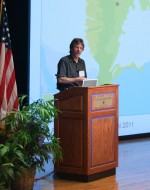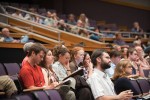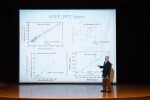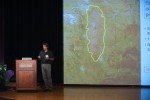Kansas State University recently hosted an international symposium entitled “Grasslands in a Global Context" to celebrate two important milestones: 40 years since the establishment of the Konza Prairie Biological Station (KPBS) and 30 years since the Konza Prairie (KNZ) Long-Term Ecological Research (LTER) program was launched.
In that time, KPBS and the associated KNZ program have grown into a world-class grassland ecological research facility and program, which supports the research activities of scientists and students from institutions across the U.S., and collaborates with international scientists from around the world. The effort has produced over 1,100 articles in multiple scientific journals and books and more than 230 student theses and dissertations. In addition to providing a deeper understanding of ecological processes in grasslands, Konza research has contributed to synthesis and conceptual and theoretical advances in general ecology, addressed applied aspects of grassland management, and contributed to governmental policy decisions.
To celebrate these milestones, we invited internationally-recognized leaders with extensive experience in multiple grassland ecosystems and paired them up with current KNZ LTER investigators. Presenters and panelists at the meeting were tasked with developing a current synthesis of grassland and savanna-grassland ecosystems based on a comparative analysis of studies at the Konza Prairie and at grasslands in different world regions and with different climates and evolutionary histories. An important aim of the conference was to synthesize key findings from 40-years of research in tallgrass prairie at the KPBS and compare these to results from other grass-dominated ecosystems. The goal was to identify generalities in the structure and function of grassland and savanna ecosystems around the globe while recognizing important continental level differences and identifying significant research gaps that can drive future studies.
The three-day symposium featured about 200 participants representing more than 30 institutions across five continents. In addition to current KNZ LTER scientists from Kansas State, Colorado State, Oklahoma State, Southern Illinois, Yale, and the University of New Mexico, invited speakers and panelists included:
- Osvaldo Sala (Arizona State)
- Peter Adler (Utah State)
- Sally Archibald (CSIR, South Africa)
- William Bond (Univ. of Cape Town, South Africa)
- David Briske (Texas A&M)
- Harmony Dalgleish (Purdue)
- Doug Frank (Syracuse)
- Sam Fuhlendorf (Oklahoma State)
- Nancy Grimm (Arizona State)
- Richard Hobbs (Univ. of Western Australia)
- Herbert Prins (Wageningen Univ., The Netherlands)
- Bob Scholes (CSIR, South Africa)
- David Tilman (Univ. of Minnesota)
- Shiqiang Wan (Henan Normal Univ. and CAS, China)
The symposium included presentations on a wide range of ecological processes and dynamics in both terrestrial and aquatic grassland communities and ecosystems. A critical feature of the conference was grouping presentations by thematic area, with local and international speakers paired to maximize our ability to recognize key similarities and differences in the drivers that affect grassland structure and functioning globally. In addition, the third day of the conference was dedicated to perspectives from a synthesis panel and the structured exchange of ideas and synthesis among participants, in which each was challenged to look at the ecology of grasslands and savannas in new ways. In addition to oral presentations and panel discussions, participants presented over 60 posters and took advantage of numerous opportunities for informal interactions, including a bison barbecue at the KPBS.
The symposium was sponsored by the Institute for Grassland Studies (IGS), a Targeted Excellence Program of Kansas State University established in 2008 to promote professional scientific interactions among international grassland scientists in ways that foster new research and educational opportunities, and the synthesis and application of grassland science for improved conservation and global sustainability.

 Enlarge this image
Enlarge this image


